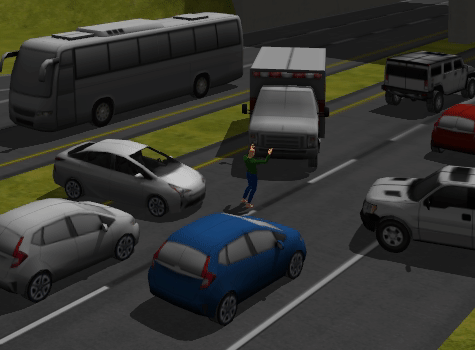
Robot simulation made easy.
Why Gazebo?
Robot simulation is an essential tool in every roboticist's toolbox. A well-designed simulator makes it possible to rapidly test algorithms, design robots, perform regression testing, and train AI system using realistic scenarios. Gazebo offers the ability to accurately and efficiently simulate populations of robots in complex indoor and outdoor environments. At your fingertips is a robust physics engine, high-quality graphics, and convenient programmatic and graphical interfaces. Best of all, Gazebo is free with a vibrant community.
The Latest
Gazebo 11.0.0 release
2019-01-30
Release Highlights
- SDFormat 1.7 frame semantics, see the ROSCon 2019 talk
- Support for BVH skeletal animations
- Slow motion / sped up log playback
- Tracked vehicles with flippers
- Dynamic bias noise for sensors
- STLB mesh support and improved SVG parsing
- Spherical sonar
- Bumped Ignition dependencies to match Ignition Citadel:



We are proud to announce the release of Gazebo 11. This version of Gazebo has long term support with an end-of-life on January 29, 2025.
We've also released new minor versions for Gazebo 9 and 10:
The first stable release of Gazebo came out on October 2012. Now, almost 8 years and 10 major releases later, Gazebo 11 marks the end of major releases from the osrf/gazebo codebase. All released versions will be supported until their end of life, receiving backwards-compatible features and bug fixes.
We'd like to thank external developers who have contributed to Gazebo over the past year:
- Silvio Traversaro
- Martin Pecka
- Mingfei Sun
- Sean Yen
- Jennifer Buehler
- Olivier Crave
- Víctor López
- Tan Benjamin
- Wei Xu
- Timo K
- Eric Timmons
- Stephen Just
- Jonathan Noyola
- Thomas Hines
- Terry Welsh
- Carlos Miguel Correia da Costa
- Yedhin Kizhakkethara
- Samuel Lekieffre

Migration to Ignition
Moving forward, the simulation team at Open Robotics will be focusing on the development of the Ignition simulation framework.
Not all features available on Gazebo 11 have been ported to Ignition yet. Likewise, Ignition offers new features which are not available on Gazebo 11. You can see the feature comparison between Ignition Citadel and Gazebo 11 here.
Both Gazebo and Ignition use SDFormat as the world description format. Therefore, worlds and models that work on Gazebo can be easily ported to Ignition.
Ignition Gazebo supports different plugin types from Gazebo-classic. Check out this tutorial for a review of plugin types and an example on how to port a plugin from Gazebo.
Improved migration guides and APIs to help the transition from Gazebo to Ignition will be coming up over the next few months.
Gazebo Development Team
Useful Links
Answers
Find answers and ask questions.
Community
Join for discussions and announcements.
Simulation Models
Robots, objects, and other simulation models.
Source code
Get Gazebo's source code.
Features
Advanced 3D Graphics
Utilizing OGRE, Gazebo provides realistic rendering of environments including high-quality lighting, shadows, and textures.
Sensors and Noise
Generate sensor data, optionally with noise, from laser range finders, 2D/3D cameras, Kinect style sensors, contact sensors, force-torque, and more.
Plugins
Develop custom plugins for robot, sensor, and environmental control. Plugins provide direct access to Gazebo's API.
Robot Models
Many robots are provided including PR2, Pioneer2 DX, iRobot Create, and TurtleBot. Or build your own using SDF.
TCP/IP Transport
Run simulation on remote servers, and interface to Gazebo through socket-based message passing using Google Protobufs.
Command Line Tools
Extensive command line tools facilitate simulation introspection and control.
Get Started
Get your feet wet
- Quick Start
A simple set of steps to get Gazebo up and running rapidly.
- GUI Hotkeys
Description of Gazebo's hotkeys and mouse interactions.
- Tutorials
The best way to start using Gazebo is to run through the tutorials. These tutorials cover both basic and simple concepts through a series of exercises.
- Examples
Check out the example worlds and programs that are in the source code.
- answers.gazebosim.org
If you can't find what you are looking for, try our askbot help forum located at answers.gazebosim.org.
- community.gazebosim.org
Want to exchange ideas with the rest of the community? Come to community.gazebosim.org.
Information Sources
- Gazebo Overview
A high-level description of Gazebo and its various components.
- Gazebo API
Doxygen generated documentation for the Gazebo libraries.
- Protobuf Messages
A complete list of all the protobuf messages used by Gazebo
- SDFormat Specification
SDFormat is an XML file format that defines environments and models. This specification defines all the XML elements for describing world and models.
Project Status
Release Schedule and Roadmap
Gazebo 11 is the last major release of Gazebo. All currently supported Gazebo versions are still being maintained and may receive new backwards-compatible features and bug fixes until their end-of-life.
Gazebo is being refactored into the new Ignition Gazebo simulator. Check out Ignition Robotics to learn all about it.
Refer documentation in downstream applications, such as ROS, for version compatiblilty.
Gazebo 1.9 2013-07-24 EOL 2015-07-27
- Split out SDFormat into a separate package
- Improved ROS support
- Added Sonar, Force-torque, and pressure sensors
- Allow user camera to follow objects
- Basic OS X support
Gazebo 2.2 2013-11-07 EOL 2016-01-25
- Improved shadow maps
- Breakable walls
- Visualize moment of inertia
- Graphically resize simple shapes
- Wireless transceiver sensor models
- OpenAL audio support
- Terrain paging
Gazebo 3.0 2014-04-11 EOL 2015-07-27
- Unified command line tool
- Lightmaps for improved rendering realism
- Destructable simple shapes
- Import DEM
- Split in Debian packages, moving to Debian inclusion of Gazebo
- Beta OSX support
- Bullet support
Gazebo 4.0 2014-07-28 EOL 2016-01-25
- Vehicle suspension models
- More tutorials and documentation
- Oculus Rift support
- Razer Hydra support
- Copy and paste models via GUI
- Custom road textures
- Support DART 4.1
- New extruded polyline geometry
- Fixed actor animations
- Added KMeans class
Gazebo 5.0 2015-01-26 EOL 2017-01-25
- C++11 integration
- GUI overlay support
- Clone running simulations
- Improved building editor
- Javascript interface
Gazebo 6.0 2015-07-27 EOL 2017-01-25
- Windows support, when compiling from source
- Support for Oculus 2
- Hydrodynamics plugin
- Improved aerodynamics plugin
- Multiple physics profiles per world
- Apply forces and torques via the GUI
- Import shapes by extruding SVG files
- Collision bitmask support in SDF
- Elevator and teleport plugins
- Actuator plugin that enforces torque limit based on joint velocity
Gazebo 7.1 2016-01-25 EOL 2021-01-25
- Nested models
- Ignition Math integration
- Improve documentation for first time users
- Improved log recording and playback
- GUI design tools such as cut/copy/paste, and undo
- Wide angle camera sensor
- Torsional friction
- Battery class and plugin.
Gazebo 8.2 2017-12-10 EOL 2019-01-25
- GUI plotting utility and system instrospection
- GUI model editor
- Generalization of Actor animations
- QT 5 support
- Import OBJ files
- Support for Wind
- Quadcopter simulation
- Built-in video recording
Gazebo 9.0 2018-01-25 EOL 2023-01-25
- Gravity compensation plugin
- DART 6 integration with closed kinematic loops
- Integration with Ignition Fuel
- Joystick plugin
- Parallel threaded islands in ODE
- Improved shadows
- Camera lens flare
- Attach lights to links
Gazebo 10.0 2019-01-24 EOL 2021-01-24
- Check out the Changelog.
Gazebo 11.0 2020-01-30 EOL 2025-01-29
- Check out the Changelog.
Versioning
Gazebo uses semantic versioning, a package numbering scheme that specifies ABI/API compatibility between releases. A version consists of three numbers separated by decimal points: MAJOR.MINOR.PATCH:- MAJOR version changed when incompatible ABI/API changes are made
- MINOR version changed when functionality has been added in a backwards-compatible manne
- PATCH version changed when backwards-compatible bug fixes are released
Tick-tock Release Cycle
A tick-tock release cycle allows easy migration to new software versions. Obsolete Gazebo code is marked as deprecated for one major release. Deprecated code produces compile-time warnings. These warning serve as notification to users that their code should be upgraded. The next major release will remove the deprecated code.
Example where function foo is deprecated and replaced by function bar:
| Gazebo v1.0 | Gazebo v2.0 | Gazebo v3.0 | |||
|---|---|---|---|---|---|
| void foo(); |
| void bar(); |
Physics Engine Support
Gazebo supports the ODE, Bullet, Simbody and DART physics engines. By default Gazebo is compiled with support for ODE. In order to use the other engines, first make sure they are installed and then compile Gazebo from source.
| Physics Engine | Gazebo Version | Availability | Notes |
|---|---|---|---|
| ODE | 1.9+ | Binary,Source | Default engine. Gazebo maintains a fork of ODE which has diverged from the upstream package. |
| Bullet | 3.0+ | Source | Gazebo requires libbullet2.82, available in the OSRF repository and to be included in Ubuntu Utopic. |
| Simbody | 3.0+ | Source | Simbody packages are hosted in the OSRF repository. Expected to appear in Ubuntu Utopic official repositories. |
| DART | 3.0+ | Source | DART packages are hosted in dartsim PPA. DART is in the process of moving toward inclusion in Ubuntu. |
The new Ignition simulator uses a physics plugin framework to resolve dependency issues. Each physics engine is interfaced to Ignition Gazebo through a plugin, avoiding the need to compile the simulator with support for each engine. |
|||
History
Gazebo development began in the fall of 2002 at the University of Southern California. The original creators were Dr. Andrew Howard and his student Nate Koenig. The concept of a high-fidelity simulator stemmed from the need to simulate robots in outdoor environments under various conditions. As a complementary simulator to Stage, the name Gazebo was chosen as the closest structure to an outdoor stage. The name has stuck despite the fact that most users of Gazebo simulate indoor environments.
Over the years, Nate continued development of Gazebo while completing his PhD. In 2009, John Hsu, a Senior Research Engineer at Willow, integrated ROS and the PR2 into Gazebo, which has since become one the primary tools used in the ROS community. A few years later in the Spring of 2011, Willow Garage started providing financial support for the development of Gazebo. In 2012, Open Source Robotics Foundation (OSRF) spun out of Willow Garage and became the steward of the Gazebo project. After significant development effort by a team of talented individuals, OSRF used Gazebo to run the Virtual Robotics Challenge, a component in the DARPA Robotics Challenge, in July of 2013.
OSRF continues development of Gazebo with support from a diverse and active community. Stay tuned for more exciting developments related to robot simulation.








